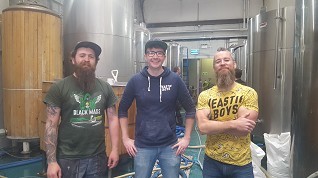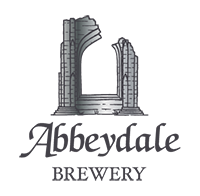Pitching in with Yeastie Boys

Let’s just get this out of the way before I begin… Yeastie Boys’ XeRRex is my number 1 beer. Made with 100% peated malt it’s also one of the most obnoxious and bonkers beers possible. And I love it. Yeastie Boys are well known for their dynamic and avant garde approach to brewing and the prospect of working with them as our first Funk Dungeon collaboration blew me away. Having hit it off straight away with Yeastie Boys brewer JK when we first met a few months ago, where we chatted about our joint love of mixed fermentation beers (both in the drinking and the production of them), it seemed the best course of action would be to brew one together.
Our goal was a little loose from the start, but we knew we wanted to create something along the lines of an weizen base beer which we planned to ferment using mixed cultures, and we had a 27 hectolitre brewlength to play around with. So, on the face of it, the brew was pretty simple. Obviously that meant we had to go ahead and complicate matters.
The main fun began a week before collaboration day with preparing our Brett and Lacto house pitch. We were keen to investigate the fermentation characteristics of bio-transformation between Brettanomyces and Sacchromyces. So we needed a really healthy and active Brett pitch, due to its renown for slow primary fermentation, to ensure it was in full swing ready to interact with the ale yeast.
Our house Brett blend is comprised of upwards of 12 yeasts that we can use for both primary and secondary fermentation, making it perfect for this beer as we were aiming for a vigorous primary fermentation and a slow conditioning period. To get enough Brett we had to step up our pitch from 40l to around 250l to ensure the growth was healthy. So we used the first runnings off the main wort stream from a couple of brews prior to the collaboration day to collect the 250l required. At this stage, we added a quick, clean Lacto Plantarum pitch and Lacto Brevis to provide a pleasant lemony acidity to match with the herb additions we were going to be using in the collaboration brew. Over the propagation period we saw an active fermentation that was more attenuative than we had anticipated. In 5 days we saw a drop in gravity from 1050 down to 1006 with a drop in pH from 4.95 to 3.30, resulting in a very clean lemony Lacto tang in the flavour, which was very promising for the character of the eventual brew.
So on collaboration day itself we welcomed JK and Charlie to Sheffield and got to work. The grist was comprised of roughly equal parts malted barley, wheat and torrified spelt. We were hoping for a higher starting gravity than we got – we think this is because the spelt in the grist yielded such a small amount of sugar, probably due to it having a large crush, so the potential sugar is trapped and difficult to access for an iso-thermal mash. It was the first time we’ve brewed with spelt, so this is all part of the constant learning curve that is the life of a brewer.
We chose to add spelt as it’s known for contributing a lemony character, which we felt would work well with the Lacto in the brew. To enhance this further we chose to use lemon verbena and lemongrass in lieu of hops, meaning the hop back became more of a herb-back for the day.
We then transferred the Bretty wort from the IBC used for propagation into the fermenter, and started collecting the herb-infused wort brewed that day on top of it.
Once all the new wort was safely in the fermenter and mixed in with the living Brett culture, we pitched the Sacchromyces. We opted to use a Munich yeast from Lallemand, a classic German wheat beer strain known for its massive banana and clove notes. Munich has a big character which we’re very familiar with, meaning we’d be able to continue to pick out this character and how it changes based on interaction with the Brett. We wanted this yeast to be secondary to the Brett, letting the Brett have a little head start, so opted not to rehydrate as well as underpitch, this way stressing the yeast and giving it a better environment in which to create all the well known esters we know from a classic wheat beer.
We had collected slightly warmer than normal at around 22C and then let the fermenter free rise to 24.5C. This was to encourage the Lacto to play it’s part on the full brew. As well as this, the fact we’d chosen not to use hops meant the Lacto was uninhibited by hop presence and could start working happily on lowering the pH.
Fermentation went smoothly and within four days from starting at 1041 was down to 1008, with the pH falling from 4.95 to 3.35. We dropped the temp of the tank to 11C to sediment some of the Munich yeast, as it’s far more flocculent than the Brett, then let the temperature free rise again to around 15C to encourage the Brett to continue acting upon the beer via secondary fermentation and long conditioning. The beer is now safely stored in conditioning tank where we expect it to remain for around another month, and we also have a little more squirelled away in wood for extended ageing.
We plan to co-launch the beer at two very special events over this coming August Bank Holiday, Yeastie Boys’ 10th birthday party in London, where we’re one of 10 breweries who have collaborated them, and our very own Funk Fest held right here in the brewery itself! So get yourself along to one of these for the first taste of our as-yet-unnamed bretted sour spelt weizen. We can’t wait to see how it develops!
Cheers!
Jim Rangeley
Funk Dungeon Lead Brewer
Funk Fest tickets are available here and more details about Yeastie Boys X are here.




